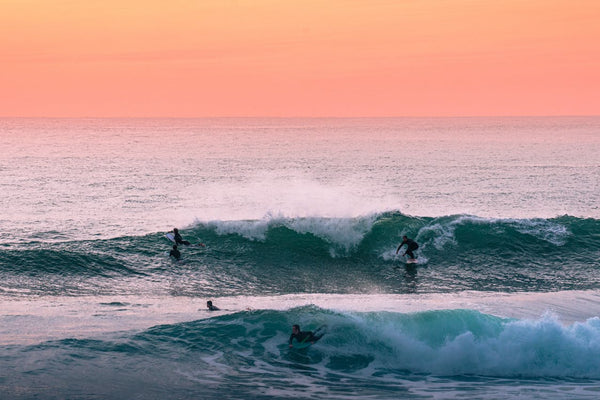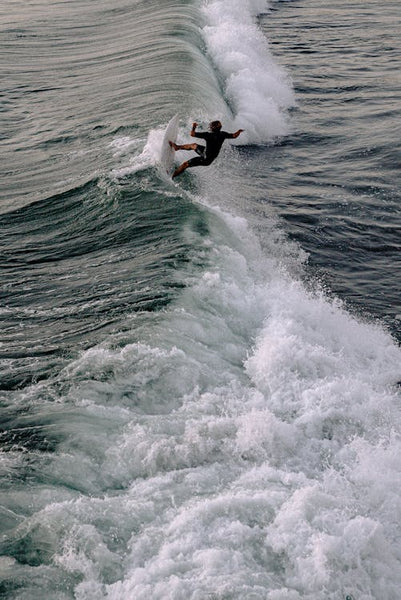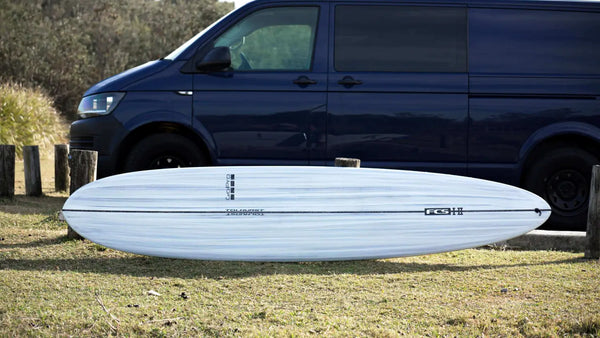How to Surf Better Part 4 of 9: Riding the Wave
Share
Once you get to your feet and are actually surfing the wave, that’s when the fun really starts. But there’s a difference between riding a wave and riding a wave well
—and the better you get at surfing, the more you will be able to do and the more fun you will have.

The Thrill of Surfing: Beyond Just Riding the Wave
A lot of people try to start ripping as soon as they start surfing—but that’s a lot like trying to learn to run before you can walk. Without learning the basic fundamentals of surfing, you will never develop proper technique and your maneuvers won’t be efficient or stylish. While basic actions like pumping down the line and wrapping a carving cutback into the pocket might not be as exciting as airs and barrel rides, they are the building blocks of these more aggressive maneuvers. Without them, you’ll never be able to take your surfing to the next level.
Surfing Fundamentals: The Building Blocks of Advanced Maneuvers
The single best thing you can do to learn the basics of wave riding is something that virtually no one does—in fact, most beginners do the exact opposite. This key strategy is to ride bigger boards! When you size down your boards too soon (which is to say, before you have developed the basic fundamentals of surfing), you might feel like you are ripping, but in reality, you are simply tricking yourself into thinking that you are doing maneuvers. Smaller boards are more nimble and turn more easily, but for this very reason they are style and technique killers, since they don’t require you to correctly use your rail to change direction. Adding a few inches to your shortboard, however, has the opposite effect—it makes your board feel slower and less maneuverable, which in turn forces you to use proper body mechanics and rail work to make basic direction changes. The end result is a forced lesson in technique that will pay dividends when you are finally ready to graduate to a smaller board.
In addition to practicing on bigger boards, there are a few specific body mechanics you can use to clean up your style and make your surfing more efficient. The first is related to pumping and generating speed. Beginner surfers typically just stand there and trim down the line—and there’s nothing wrong with that. Trimming is one of the purest feelings in surfing, and traditional longboarders and retro board enthusiasts still celebrate a clean trim as one of the most important maneuvers in surfing. But if you are riding anything other than a log, there will come a time when you find you want more speed than the wave naturally provides. In this case, it is up to you to generate your own speed, which is accomplished through pumping.
Enhancing Surfing Efficiency: Body Mechanics and Pumping
The biggest mistake most beginners make when it comes to generating speed is that they hop or bounce instead of pumping. Hopping in an up and down motion does not make your board move faster down the line. In fact, it slows you down because it repeatedly breaks the plane of the board on the water, which is where speed is generated. Unfortunately, when beginners see expert surfers pumping, their minds misinterpret the pump as a hop, and they end up copying what they think they are seeing, rather than what proficient surfers are actually doing.
To correctly pump down the line, the board is surfed up and down the face, without ever breaking the contact of the planing surface with the water. The board is moving up and down—but in two three dimensions rather than two. This generates speed in two ways. First, it allows you to use gravity as you climb and descend the wall of the wave. Secondly—and more importantly, it allows you to tap into the energy of the wave itself, using the motion of the water as it pulls off the bottom of the ocean and up the face.
Pumping Technique: Maximizing Speed on the Wave
When learning to pump, it is best to start slow. Rather than trying to blast down the line, think of the pump as a series of rock-and-roll maneuvers, where you are carving up and down the face. These mini-turns serve as rudimentary pumps, but they will also form the foundation of bottom turn/top turn combinations when you become a more advanced surfer. As you become more comfortable rock-and-rolling, you can do it faster and tighter, and eventually these mini-turns will blend into efficient pumping.
Once you become good at generating speed, you will find that you begin to outrun sections. This is a good thing if you are taking off behind a section or driving through a deep barrel, but it can be frustrating if you get out in front of the section, because no one wants to spend their entire wave riding on the shoulder. We want to be in the pocket, where all the energy is!
Advanced Surfing: Outrunning Sections and Staying in the Pocket
There are a number of ways to return to the power source, but one of the most classic, stylish, fun, and efficient ways is through the roundhouse cutback. In addition to getting you back into the pocket, the roundhouse also serves as the foundation of virtually all other maneuvers you will learn to do on a surfboard.

The Roundhouse Cutback: A Classic Maneuver to Master
The roundhouse cutback is essentially a drawn-out carve performed laterally on the face. As you approach the shoulder, initiate a small bottom turn to break your lateral motion, then shift the weight from your inside rail to your outside rail while turning your head, upper body, and eventually torso and hips back toward the whitewater. Remember, your body follows your head, your legs follow your body, and your surfboard follows your legs, so it’s essential that your eyes look where you want to go. Many people get excited about doing turns and generating spray, and look back at their spray to see how much water they are throwing, but this is the single worst thing you can do while carving a turn, as it disrupts the flow of your head/body/legs/board alignment.
While carving through your roundhouse, your arm position is also important. The front arm should act as a static point around which the board and the rest of your body pivot. Meanwhile, your back arm is what drives your board through the turn. Extend the arm so that your hand is parallel to your inside rail, then keep it in place throughout the turn, as if it is connected to your rail with an invisible line that drives the board through your turn. If you study the carves done by the world’s best power surfers (such as Taylor Knox, Mick Fanning, and more recently, Ethan Ewing), you will note that their arm placement is perfect, both technically and aesthetically. This is not a happy accident. These guys practiced for hundreds of hours to get their arm placement correct, and this has a direct impact on the power, speed, and fluidity of their turns.
Once you wrap your cutback all the way around, you have a few options. You can redirect your weight back to the inside rail and quickly terminate the turn, effectively limiting it to a single carving slash. Or you can do the opposite and follow through with the carve all the way back to the whitewater, where you can rebound off the foamball. More aggressive versions of this rebound see the board going vertical and doing what is essentially a top turn off of the whitewater/foamball. Finally, you can split the difference between the two, completing the full carve and then pushing hard through the back foot to release the fins into a tailslide, or even a sliding 360.
Finishing the Cutback: Options and Techniques
Once you complete the back half of your turn, your board will naturally realign itself with the nose pointing toward the shoulder and the fins back behind you near the pocket. This is due to the fact that fins do not track well backwards, but will instead always try to right themselves and make the board ride straight. Of course, the goal is not for the board to get your board back into position, but for you to do so through smoothly linked turns. But we will learn more about linking maneuvers in another post. For now, the goal is to slow down your surfing, ride bigger boards, and start focusing on rock-and-rolling for speed and carving from the shoulder back to the pocket. After all, what’s more fun than going as fast as possible in the speediest part of a wave?
More Articles👈

